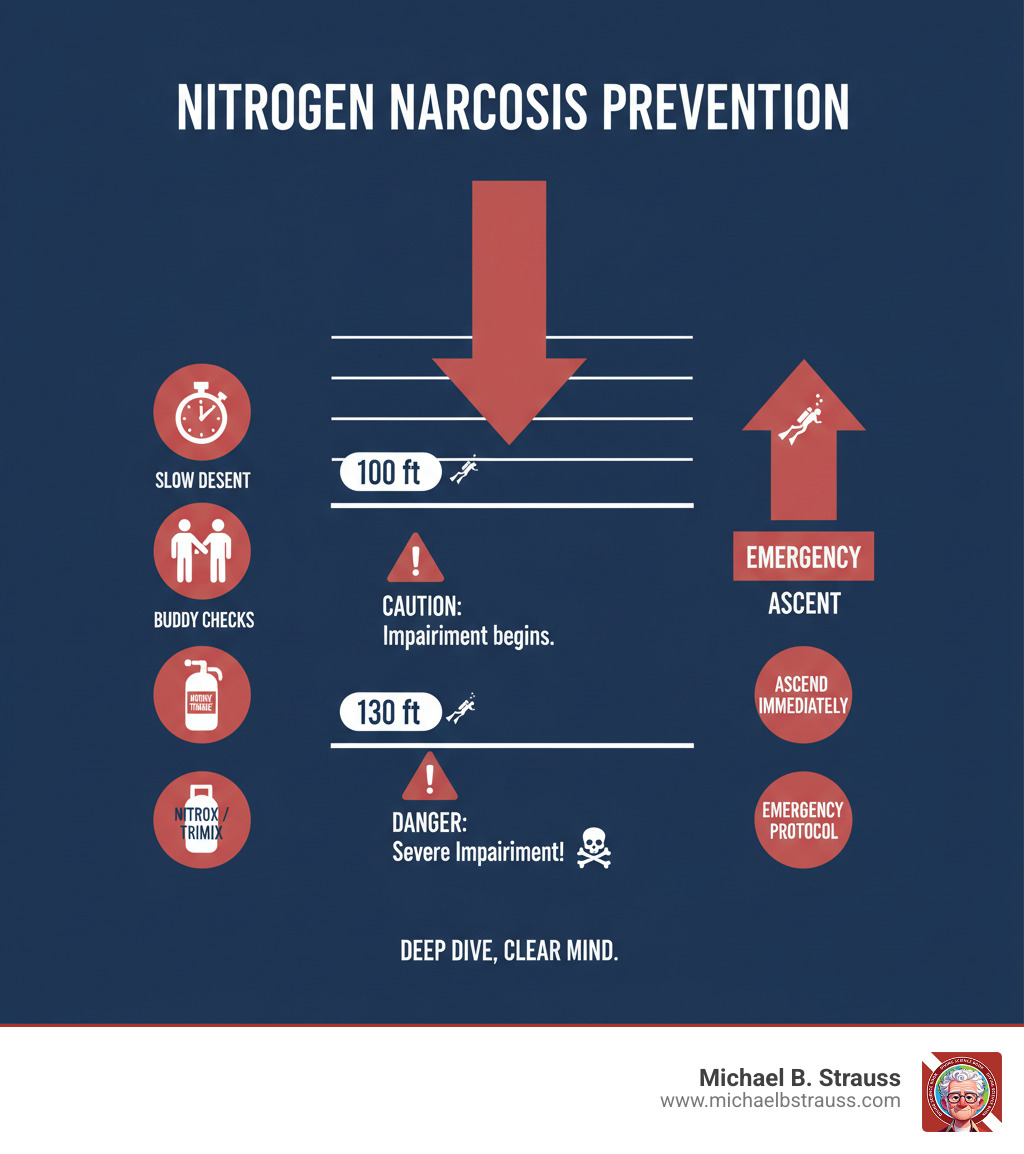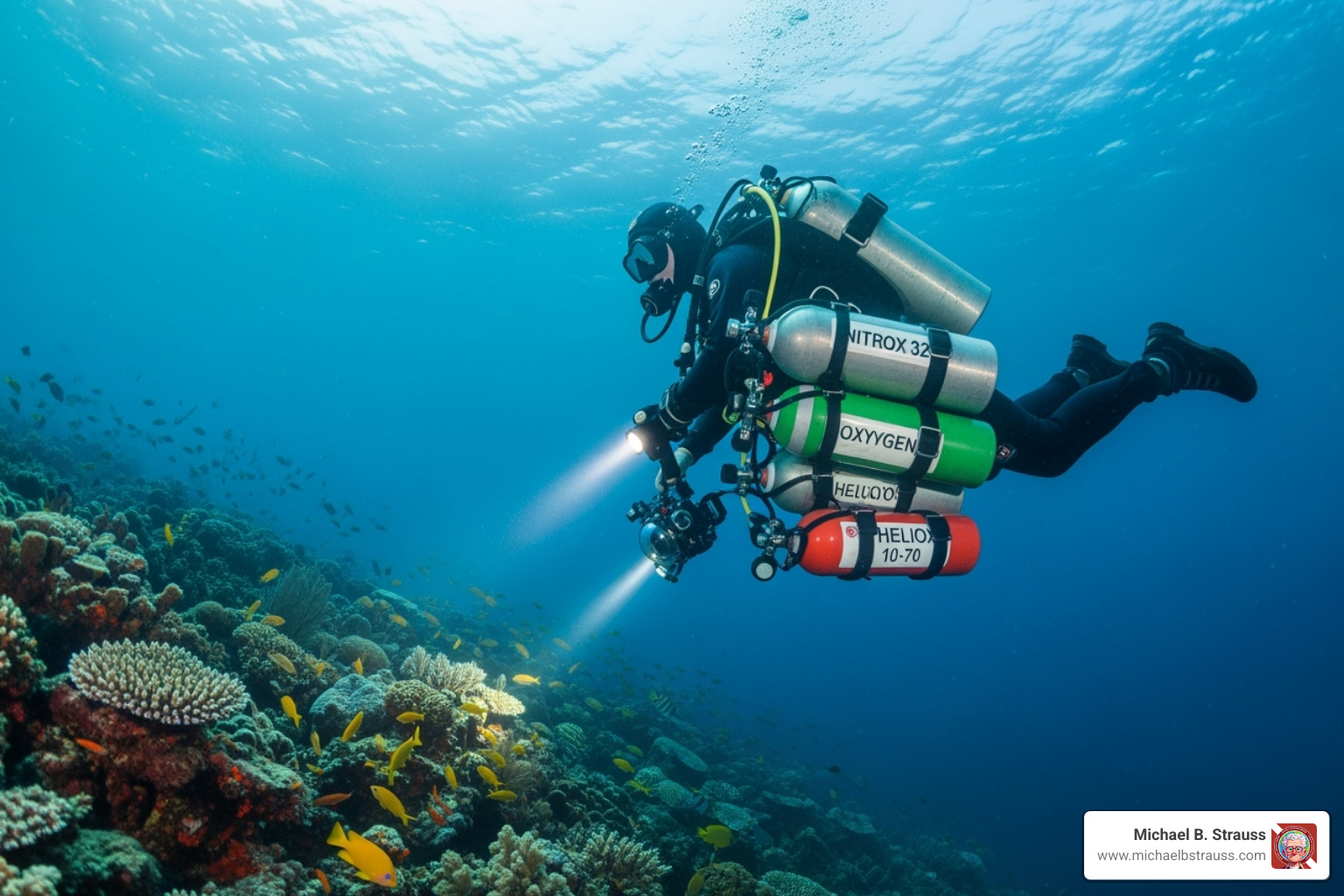Why Nitrogen Narcosis Prevention Matters for Deep Diving Safety
Nitrogen narcosis prevention is critical for any diver venturing beyond 100 feet, where the risk of impairment becomes almost certain. This condition, also known as "rapture of the deep," occurs when nitrogen gas dissolves into your nervous system under pressure, creating alcohol-like symptoms that can be deadly underwater.
Quick Prevention Strategies:
- Stay above 100 feet when using compressed air
- Descend slowly to minimize rapid nitrogen absorption
- Use enriched air nitrox or trimix for deeper dives
- Maintain excellent physical condition - well-rested and hydrated
- Practice buddy monitoring and frequent gauge checks
- Ascend immediately if symptoms appear
The threat of nitrogen narcosis—not decompression sickness—is the primary reason recreational diving limits are set at 130 feet. At this depth, most divers experience significant impairment that affects judgment, coordination, and decision-making.
As one diving expert puts it: "When you're narced and feeling good, you're not getting high — you're getting comatose." This sobering reality highlights why prevention is essential for safe deep diving.
The good news is that nitrogen narcosis is completely reversible. Ascending just 10-20 feet often clears symptoms immediately, with no lasting effects once you surface.

Understanding "Rapture of the Deep": What is Nitrogen Narcosis?
Imagine descending into the blue when a strange, euphoric sensation washes over you. Your thoughts become hazy and your movements uncoordinated. This isn't just a powerful dive experience; it could be nitrogen narcosis, a condition every diver must understand.
Nitrogen narcosis, or "rapture of the deep," is a temporary alteration in consciousness that divers experience when breathing compressed gases at depth. While commonly called "nitrogen narcosis," it's more accurately "inert gas narcosis," but nitrogen is the primary culprit in recreational diving. The condition is often compared to alcohol intoxication, earning it the nickname "the martini effect." "Martini's Law" humorously suggests that every 10 meters (approximately 33 feet) of descent is like consuming one martini, helping to illustrate the progressive nature of the impairment. Scientific research on inert gas narcosis explores the physiological mechanisms behind this phenomenon.
What Causes Nitrogen Narcosis?
The primary cause is the increased partial pressure of nitrogen as we dive deeper. As ambient pressure increases, the nitrogen we breathe dissolves into body tissues, particularly affecting the central nervous system. This interferes with neuronal transmission, slowing brain activity and impairing cognitive function.
While the exact mechanism is debated, the leading theory (the Meyer-Overton hypothesis) suggests that nitrogen dissolves into the fatty lipid membranes of nerve cells. This disrupts their normal function and interferes with nerve impulses. Other theories propose that nitrogen directly affects neurotransmitters in the brain. Factors like carbon dioxide (CO2) buildup, cold, and anxiety can also exacerbate its effects.
Nitrogen Narcosis vs. Decompression Sickness
It's crucial to distinguish nitrogen narcosis prevention from managing decompression sickness (DCS). While both are pressure-related, they are very different:
| Feature | Nitrogen Narcosis | Decompression Sickness (DCS) |
|---|---|---|
| Cause | High partial pressure of inert gases (primarily nitrogen) affecting the CNS. | Rapid decrease in ambient pressure causing dissolved inert gases (nitrogen) to form bubbles in tissues and bloodstream. |
| Onset | During the dive, at depth (typically >100 feet/30 meters). Symptoms resolve on ascent. | After the dive, during or after ascent, sometimes hours later. |
| Symptoms | Impaired judgment, euphoria, anxiety, confusion, disorientation, slowed thinking, motor skill impairment (like being drunk). | Joint pain ("the bends"), skin rashes, fatigue, neurological deficits (numbness, paralysis), dizziness, shortness of breath. |
| Treatment | Immediate, controlled ascent to shallower depth until symptoms clear. Abort dive if symptoms persist. | Recompression in a hyperbaric chamber with 100% oxygen. |
| Long-Term Effects | None, symptoms completely reversible upon ascent. | Can cause permanent tissue damage, neurological impairment, or even death if untreated or severe. |
In short, narcosis is an in-dive problem that resolves on ascent, while DCS is an after-dive problem related to off-gassing. The threat of narcosis is the primary reason for the 130-foot recreational depth limit, highlighting the need for management. For a deeper understanding of the physics behind these phenomena, explore Decompression Science.

Proactive Nitrogen Narcosis Prevention Strategies
The best defense against nitrogen narcosis is a good offense. Smart divers use a combination of careful planning, proper training, and disciplined in-water techniques to stay sharp and safe at depth.
Pre-Dive Planning for Nitrogen Narcosis Prevention
Dive safety starts on the surface. Your pre-dive decisions directly impact how you handle pressure below.
- Respect your limits. The 130-foot recreational depth limit exists because of narcosis. Most divers feel noticeable impairment around 100 feet, so don't let ego push you deeper than you're prepared for.
- Mind your physical condition. Being well-rested and hydrated is crucial, as fatigue and dehydration can worsen narcosis. Avoid diving when your body isn't ready.
- Avoid alcohol and sedatives. Even alcohol from the previous night can increase susceptibility. Your brain needs to be at its best.
- Manage pre-dive anxiety. Stress can amplify narcosis. A calm mindset is key; consider a shallower dive if you feel anxious.
- Create and follow a detailed dive plan. Include maximum depth, bottom time, and gas management. When narcosis clouds your judgment, a clear plan is your lifeline. For deeper insights into the science behind safe diving practices, explore Diving Science.
The Role of Training and Alternative Gases

Proper training is essential. If you plan to dive beyond 60 feet regularly, an Advanced Open Water certification is a logical next step, followed by the Deep Diver specialty to manage the challenges of deeper environments.
Experience helps, but doesn't grant immunity. Experienced divers learn to recognize and manage symptoms through gradual exposure and practice.
Smart gas choices dramatically reduce narcosis risk by lowering the amount of nitrogen you breathe.
- Enriched Air Nitrox contains less nitrogen than air, reducing the narcotic effect at any given depth. It's a popular choice for recreational dives between 60-100 feet.
- For deeper technical diving, Trimix and Heliox replace much of the nitrogen with virtually non-narcotic helium. The trade-off is that helium is expensive, increases heat loss, and requires complex decompression planning.
- Calculating your Equivalent Narcotic Depth (END) helps you predict how "narcotic" your gas mixture will feel at your planned depth, allowing you to prepare for potential impairment.
In-Water Techniques for Nitrogen Narcosis Prevention
Once underwater, your behavior is the final line of defense.
- Descend slowly. A controlled descent gives your body time to adjust to the pressure.
- Use the buddy system. Monitor each other for signs of confusion or strange behavior. Frequent communication helps assess if you're both thinking clearly.
- Trust your gauges, not your feelings. Narcosis can make you forget to check your instruments or doubt what they say. Your computer doesn't get narced—you do.
- Avoid overexertion. Hard work increases CO2 buildup, which is also narcotic and can worsen narcosis. Swim slowly and breathe deeply.
- Stay warm. Cold increases susceptibility to narcosis. Proper thermal protection is essential safety equipment for deep dives.
- Keep tasks simple at depth. Narcosis impairs multitasking. Practice with new gear in shallow water and use a dive slate for important information.
Nitrogen narcosis prevention is about layering multiple strategies to keep yourself safe and clear-headed when the pressure starts playing tricks on your mind.
Recognizing Symptoms and Responding Effectively
Even with the best nitrogen narcosis prevention strategies, every diver must know how to recognize the warning signs and respond quickly. This knowledge is your underwater safety net.
Early to Severe: Identifying the Signs of Narcosis
Nitrogen narcosis is sneaky. Its symptoms can appear suddenly and vary between individuals and even between dives for the same person.

Early signs, often starting around 100 feet, can include euphoria or mild anxiety. Cognitive symptoms are key red flags: slowed thinking, impaired judgment, and difficulty concentrating or remembering the dive plan. Physical symptoms often follow, including loss of coordination, numbness in the lips or fingers, and light-headedness.
As you go deeper, symptoms worsen to include disorientation, fixation on objects, and inappropriate behavior. At extreme depths, hallucinations, stupor, or loss of consciousness can occur, creating a life-threatening situation.
Common Nitrogen Narcosis Symptoms (from mild to severe):
- 100 feet: Euphoria, mild anxiety, impaired judgment, slowed thinking, memory issues, difficulty concentrating, visual disturbances, light-headedness
- 130+ feet: Disorientation, reduced coordination, inappropriate behavior, fixation on objects, numbness, ringing in ears
- 200+ feet: Hallucinations, stupor, coma, potential death from drowning or accidents
A narced diver often doesn't realize they're impaired, making buddy checks crucial. Simple cognitive tests, like asking your buddy to add numbers on their fingers, can quickly reveal problems.
What to Do if You or Your Buddy Feels "Narced"
The good news is that nitrogen narcosis is completely reversible by ascending. Unlike DCS, symptoms clear almost instantly when you reduce pressure.
- Signal your buddy immediately. If you suspect narcosis in yourself or your buddy, signal to ascend.
- Ascend slowly. Begin a slow, controlled ascent together. A rapid ascent creates its own dangers.
- Assess your condition. Symptoms are dramatically reversible. Ascending just 10 to 20 feet can clear your head completely in seconds.
- Communicate and decide. Once clear-headed, communicate with your buddy. If symptoms persist after ascending to a shallower depth, or if they were severe, abort the dive. Ascend to the surface, completing all necessary safety stops.
Never try to "tough it out" or push through narcosis symptoms. Your brain is your most important piece of life-support equipment underwater.
Diving Safely: Complications and Final Thoughts
While narcosis itself causes no permanent damage, the impaired decision-making it creates can lead to fatal accidents. The biggest drowning risk comes from poor judgment. A narced diver might ignore a low air supply, go deeper instead of shallower, or perform other dangerous actions that seem logical in their impaired state.
Decompression sickness risk also increases when narcosis impairs your ability to follow proper ascent procedures, like missing safety stops.
Fortunately, post-dive recovery is complete. Once you surface, there are no lasting effects from narcosis.
Dr. Michael B. Strauss emphasizes in his comprehensive diving guides that understanding these risks is fundamental to diving safety. His books provide invaluable insights for divers at every level, helping you build the knowledge needed to handle challenging situations.
Nitrogen narcosis prevention remains your best defense, but knowing how to respond to symptoms ensures you're prepared. With proper training and vigilance, you can explore the underwater world safely. To build the ultimate foundation of knowledge for handling any challenging situation, get your copy of Diving Science Revisited today.
DISCLAIMER: Articles are for "EDUCATIONAL PURPOSES ONLY", not to be considered advice or recommendations.






